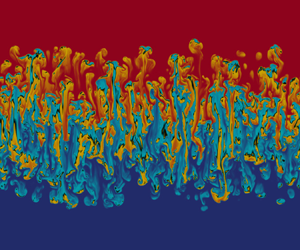Article contents
Turbulent mixing in the vertical magnetic Rayleigh–Taylor instability
Published online by Cambridge University Press: 11 January 2024
Abstract

The presence of a mean magnetic field aligned with the direction of the acceleration greatly modifies the development of the Rayleigh–Taylor instability (RTI). High resolution direct numerical simulations of the Boussinesq–Navier–Stokes equations under the magnetohydrodynamics approximation reveal that, after an initial damping of the perturbations at the interface between the two miscible fluids, a rapid increase of the mixing layer is observed. Structures are significantly stretched in the vertical direction because magnetic tension prevents small-scale shear instabilities. When the vertical turbulent velocity exceeds the Alfvén velocity, the flow transitions to turbulence, structures break and an enhanced mixing occurs with strong dissipation. Afterwards, the mixing zone slows down and its growth rate is decreased compared to the hydrodynamic case. For larger magnitudes of the mean magnetic field, a strong anisotropy persists, and an increased fraction of potential energy injected into the system is lost into turbulent magnetic energy: as a consequence, the mixing zone growth rate is decreased even more. This phenomenology is embedded in a general buoyancy-drag equation, derived from simplified equations that reflect the large-scale dynamics, in which the drag coefficient is increased by the presence of turbulent magnetic energy.
Information
- Type
- JFM Papers
- Information
- Copyright
- © The Author(s), 2024. Published by Cambridge University Press
References
- 14
- Cited by


